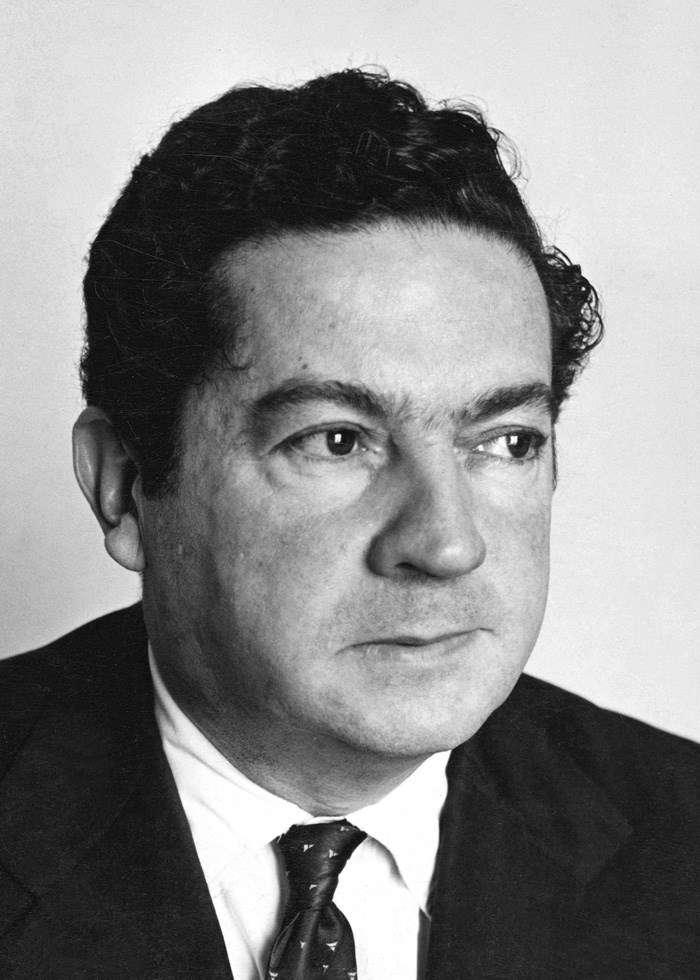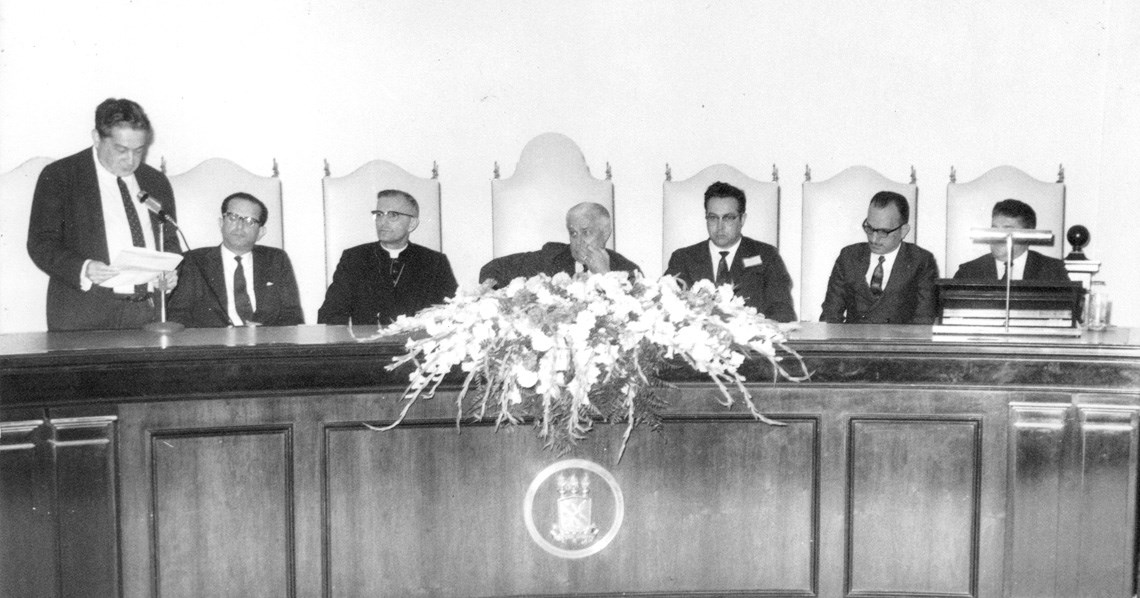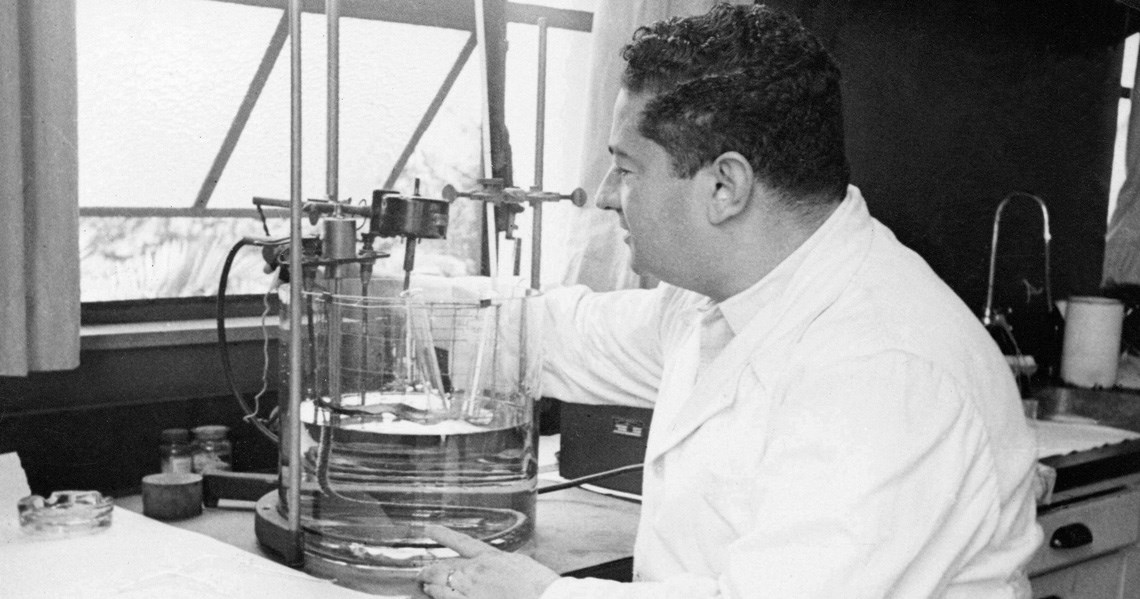One afternoon, in early December of 1947, biologist Maria Ignez da Rocha e Silva (1911–2011) answered the phone to hear her husband’s enthusiastic voice: “I think we discovered something important!” The pharmacologist from Rio de Janeiro, Maurício Oscar da Rocha e Silva (1910–1983) called from the Biological Institute of São Paulo to tell his wife that he had come across something unexpected: a slow drop in a dog’s blood pressure during a study on the effects of venom from a pit viper (Bothrops jararaca) on mammals. The following year, Rocha e Silva, physiologist Wilson Beraldo (1917–1998), and biomedical scientist Gastão Rosenfeld (1912–1990) identified a substance generated by the body itself, capable of dilating blood vessels and reducing blood pressure.
The discovery came from a dose of serendipity—or a stroke of luck. Rocha e Silva and Beraldo wanted to understand how the isolated intestine of guinea pigs (Cavia porcellus) reacted to pit viper venom, following the experimental model used at the time. They expected a quick reaction, but that is not what they observed. “They thought the experiment had gone awry,” recounts science historian Isabella Bonaventura, of the University of São Paulo, whose dissertation, to be concluded in 2023, discusses the role that Rocha e Silva and José Ribeiro do Valle (1908–2000) played in pharmacology. “But suddenly, the intestine contracted. They thought it was due to histamine, a peptide (protein fragment) released during allergic reactions.

Memory Center / Biological InstituteRocha e Silva (fourth from the left) with other researchers from the Biological Institute, in the 1950s (the director, Henrique da Rocha Lima, is ninth from the left)Memory Center / Biological Institute
Known for his fiery temperament, Rocha e Silva had previously worked with histamine and a digestive enzyme released by the pancreas, trypsin. He had also worked on inflammatory processes, which had prepared him to correctly perceive and interpret the unexpected phenomena. He and Beraldo identified that it could only be a yet unknown substance, another protein fragment that was ultimately named bradykinin in reference to two Greek words: brady (slowness) and kinein (movement).
Based on the description of bradykinin and on complementary studies performed by pharmacologist Sérgio Henrique Ferreira (1934–2016; see Pesquisa FAPESP issue no. 246), three researchers from E.R. Squibb & Sons Pharmaceuticals, currently Bristol Myers Squibb, of the United States, developed captopril, the first antihypertensive drug able to block the breakdown of bradykinin, while producing the enzyme that converts angiotensin I into angiotensin II, which increases blood pressure. Released in 1977, it became one of the most widely used drugs in the world.

Memory Center / SBPCThe pharmacologist from Rio de Janeiro coordinated a team responsible for identifying a substance capable of dilating blood vessels and reducing blood pressure: an unexpected effect of pit viper venomMemory Center / SBPC
“Rocha e Silva’s work on blood vessel dilation induced by bradykinin encouraged further studies on inflammatory processes and substances generated by the body itself that have powerful pharmacological effects, namely autacoids,” states British science historian Barbara Hawgood, of the University of London, in the United Kingdom, and author of an article on the Brazilian pharmacologist published in 1977 in the Toxicon scientific journal, for Pesquisa FAPESP.
Rocha e Silva was the son of a physician whose library “was the only place that commanded respect in our house,” as he himself recounted in his memoirs. He studied at the traditional Colégio Pedro II, was an avid reader in his adolescence, wrote some short stories, and thought about dedicating his life to literature. He was influenced to pursue medicine by his oldest brother, Olavo, a physician who taught him mathematics and science. After graduating from the School of Medicine in Rio de Janeiro, he interned at the Oswaldo Cruz Institute, but did not get along with his boss and moved to the Biological Institute in 1936, at the suggestion of his friend, immunologist Otto Bier (1906–1985).
Rocha e Silva criticized the predominant colonial mentality in Brazil, which did not encourage original scientific production, manifesting in “second-hand science,” as he called it, replicating what had already been produced in developed countries. He also challenged the then rigid hierarchy in Brazilian universities, dominated by university professors with almost absolute power over the formation of teams and research priorities. “It was a monkey on our backs,” says pharmacologist Emer Ferro, of USP’s Institute of Biomedical Sciences (ICB-USP), to describe the exclusive power of the universities’ professors on their areas of work, “and Rocha e Silva was very critical of established knowledge and authority figures.” Ferro identified another molecule able to reduce blood pressure, hemopressin, which, in 2023, he called “bradykinin’s cousin” (see Pesquisa FAPESP issues nos. 84 and 143).
Although he defended basic research and scientists’ freedom, Rocha e Silva was not opposed to applied research, which sought to resolve agricultural problems or increase the production of serums and vaccines. At the start of his career, he made an important contribution to livestock farming when he discovered that shoots from the Holocalyx glaziovii tree, which grew after fires, caused fatal poisoning in cattle in the northwestern Andradina region. He wanted to do something original and profound—and he was at the right place, because the Biological Institute was, at the time, one of the few spaces dedicated to basic research. Most institutes, like the Butantan Institute and the Agronomic Institute of Campinas (IAC), prioritized applied research, and universities were still forming.
According to Rocha e Silva, “what he was doing here was on par with the science being performed in the Northern Hemisphere, if not superior,” says Nader
In 1940, Rocha e Silva used a grant from the Guggenheim Foundation to travel to the United States. He studied at Northwestern University, in Chicago, at the Mayo Clinic, in Rochester, and at the Rockefeller Institute, in New York. When he returned to the Biological Institute, in 1942, he became the head of the Biochemistry and Pharmacodynamics department and assembled a team with various specialties, such as physiology, pharmacology, and biochemistry, which converged to form an interdisciplinary team, not common at the time. Sylvia Andrade (1921–2008), a chemist who was part of the group, was responsible for bradykinin purification, in 1955.
He spent 1946 and 1947 at the University of Toronto, in Canada, and University College London. “Rocha e Silva was a very internationalized scientist at a time when this was uncommon among Brazilians,” states science historian Maria Alice Rosa Ribeiro, of the University of Campinas’ Memory Center (CMU) and author of História, ciência e tecnologia: 70 anos do Instituto Biológico de São Paulo na defesa da agricultura, 1927-1997 (History, science, and technology: 70 years of the São Paulo Biological Institute defending agriculture, 1927–1997; Instituto Biológico, 1997).
Bonaventura adds: “Many Brazilian scientists at the time were fully aware that they were regarded as subordinates, but he always positioned himself as an equal to his international counterparts.” Biomedical scientist Helena Nader, of the Federal University of São Paulo (UNIFESP) and president of the Brazilian Academy of Sciences (ABC), agrees: “He never accepted the status of inferiority. It was as if he said what he was doing here was on par with the science being performed in the Northern Hemisphere, if not superior.”

Memory Center / SBPCStanding, reading a speech at the SBPC’s 22nd Annual Meeting, in Salvador, Bahia, 1970Memory Center / SBPC
Nader recalls that he was a centralist and was aware of the importance of his discoveries. “He was angry. They said he was aggressive; I would say incisive. He did not have an easy-going temperament,” says Nader, who met him personally in 1969. After hearing stories from those who lived with him, Emer Ferro concluded: “Rocha e Silva has a critical and frank way about him.”
The same year he discovered bradykinin, Rocha e Silva, along with other researchers from the Biological Institute, spearheaded creation of the Brazilian Society for the Advancement of Science (SBPC) to coordinate the interests of scientists and attract others motivated by science (see Pesquisa FAPESP issues nos. 268 and 270). “The SBPC was a stage for resisting the dictatorship,” recalls Nader. According to her, criticism of the military government (1964–1985) became more acute from 1977 onwards. In 1977, the government banned the SBPC from holding its annual meeting at public universities, but Archbishop Dom Paulo Evaristo Arns (1921–2016) hosted it at the Pontifical Catholic University of São Paulo.
In 1957, Rocha e Silva assumed the position of professor of pharmacology and helped organize pharmacological research at the Ribeirão Preto School of Medicine (FMRP-USP). Beginning in the 1960s, he devoted himself to the philosophy of science and, in 1968, he published Diálogo sobre a lógica da ciência (Discussion on the logic of science), with educator Anísio Teixeira (1900–1971; see Pesquisa FAPESP issue no. 303). In Mito cartesiano e outros ensaios (Cartesian myth and other essays; 1978), he lamented that many philosophers used “ultra-sophisticated and hermetic language, totally unknown to scientists.” According to Rocha e Silva, scientific knowledge, even if subject to logic and empirical testing, should always give way to the limitless human capacity to create.
Republish

